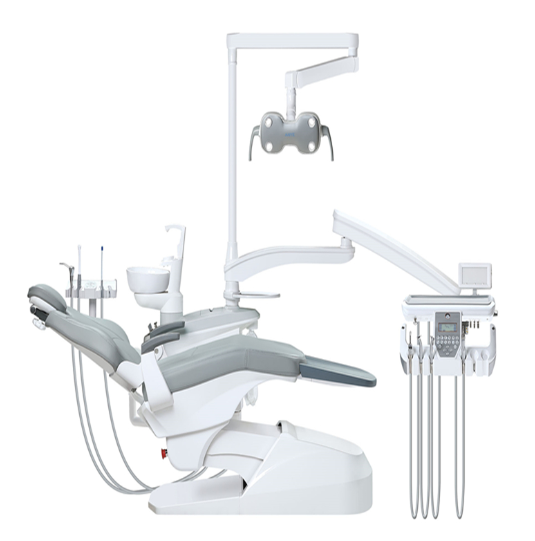Advantages and Limitations of Versatile Planting Dental Units
Dental units play a pivotal role in modern dentistry, offering essential functionalities that streamline procedures and enhance patient care. Among the various types available, versatile planting dental units stand out for their adaptability and diverse features.
Understanding their advantages and limitations is crucial for practitioners seeking to optimize their clinical workflow and patient satisfaction.
Understanding their advantages and limitations is crucial for practitioners seeking to optimize their clinical workflow and patient satisfaction.
Advantages of Versatile Planting Dental Units
In this section, the author would show you why the versatile planting dental units are popular.
●Flexibility in Configuration
Versatile planting dental units are designed to accommodate various instruments and devices, such as high-speed handpieces, ultrasonic scalers, curing lights, and intraoral cameras. This adaptability allows dentists to create personalized setups tailored to specific procedures, reducing downtime between treatments and enhancing overall efficiency.
Moreover, these units often feature multiple delivery systems, such as air-driven, electric, or hydraulic, offering practitioners the flexibility to choose systems that align with their preferred workflow and technique. This adaptability significantly contributes to a more streamlined and customized approach to patient care.
Moreover, these units often feature multiple delivery systems, such as air-driven, electric, or hydraulic, offering practitioners the flexibility to choose systems that align with their preferred workflow and technique. This adaptability significantly contributes to a more streamlined and customized approach to patient care.
●Enhanced Ergonomics
The ergonomic design of versatile planting dental units prioritizes the comfort and well-being of both the dentist and the patient. Adjustable chair positions, ergonomic instrument delivery systems, and intuitive control panels are meticulously incorporated to minimize strain and fatigue during prolonged procedures.
Furthermore, these units typically come with ergonomic-friendly features like assistant instrumentation and positioning aids, optimizing the entire dental team's workflow and ensuring a comfortable working environment.
Furthermore, these units typically come with ergonomic-friendly features like assistant instrumentation and positioning aids, optimizing the entire dental team's workflow and ensuring a comfortable working environment.
●Advanced Technology Integration
Integrating state-of-the-art technology within these units empowers dentists with advanced diagnostic capabilities and treatment modalities. Digital imaging systems, cone-beam computed tomography (CBCT), and intraoral cameras aid in accurate diagnosis, treatment planning, and patient education. Additionally, CAD/CAM capabilities enable on-site fabrication of restorations, reducing turnaround time and enhancing patient convenience.
The seamless integration of such technologies not only improves clinical outcomes but also enhances communication between the dentist and the patient, fostering a deeper understanding of treatment options and promoting informed decision-making.
The seamless integration of such technologies not only improves clinical outcomes but also enhances communication between the dentist and the patient, fostering a deeper understanding of treatment options and promoting informed decision-making.
●Space Optimization
Efficient space utilization is critical in a dental operatory. Versatile planting dental units are designed with a compact footprint, maximizing available space without compromising functionality. Storage solutions for instruments and accessories are integrated into the unit, minimizing clutter and creating a more organized workspace. This optimized layout contributes to a smoother workflow and an aesthetically pleasing environment for both practitioners and patients.
●Patient-Centered Approach
These units prioritize patient comfort and satisfaction. Adjustable chair positions, multimedia screens for patient education or entertainment, and noise-reduction features create a more relaxing and engaging experience for patients during treatments. Additionally, the ergonomic design and efficient workflow resulting from these units often lead to reduced treatment times, minimizing patient discomfort and anxiety.
Limitations
Such useful dental equipment also has some drawbacks in its applications. Here are the main limitations.
●Initial Investment Cost
The advanced features and technology integration in versatile planting dental units often come with a substantial initial cost. Practices considering these units must assess their budgetary constraints and weigh the long-term benefits against the upfront investment.
●Complex Maintenance Requirements
The sophisticated nature of these units can increase maintenance complexities. Regular servicing and repairs may require specialized technicians, leading to higher maintenance costs and potential downtimes that could affect the practice's productivity.

●Training and Familiarization
Utilizing the full potential of these units requires comprehensive training for dental practitioners and staff. Familiarization with the multitude of features, controls, and technological integrations is essential to optimize their utilization, potentially requiring additional time and resources for training.
●Compatibility Challenges
Integrating additional devices or instruments with the unit may pose compatibility challenges. Ensuring seamless integration and interoperability among different components can be a technical hurdle that demands careful consideration during procurement.
●Upgradability and Future-proofing
Keeping these units up-to-date with evolving technologies and ensuring their compatibility with future advancements in dental equipment can be a concern. Practices must strategize for continuous updates, upgrades, and potential replacements to stay abreast of technological advancements and maintain a competitive edge.
Conclusion
Versatile planting dental units offer a myriad of advantages by enhancing clinical capabilities, patient comfort, and overall workflow efficiency. However, their adoption requires careful consideration of the initial investment, maintenance complexities, and the need for ongoing training to harness their full potential.
Balancing these factors is essential for dental practices aiming to optimize patient care while managing operational aspects effectively.
Balancing these factors is essential for dental practices aiming to optimize patient care while managing operational aspects effectively.


Leave a comment